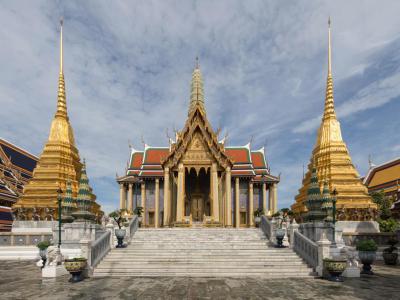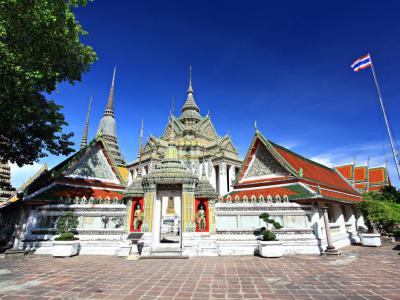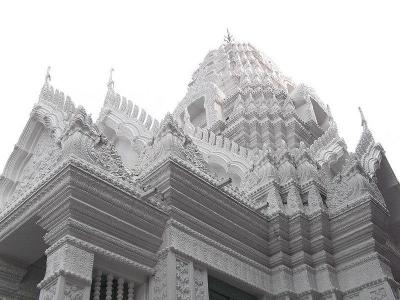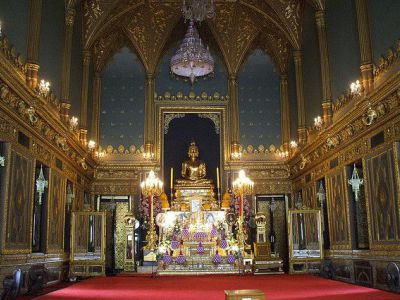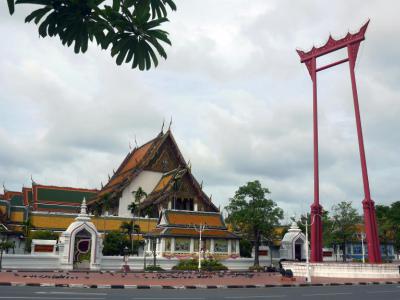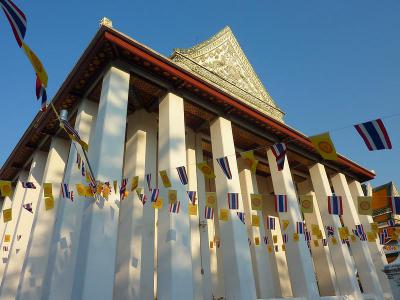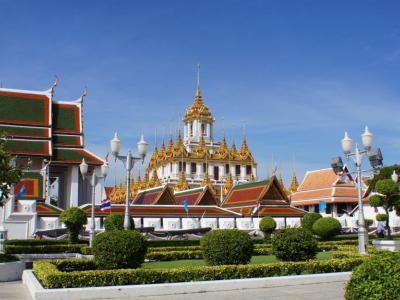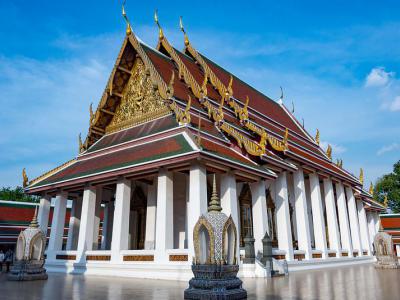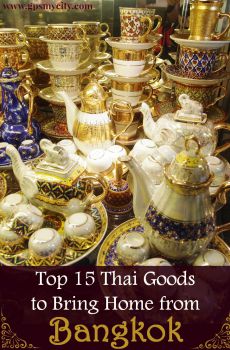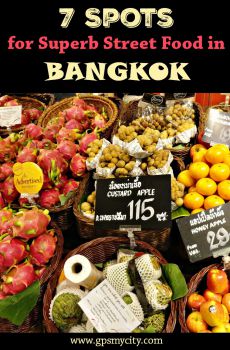
Wats and Temples of Bangkok (Self Guided), Bangkok
The “City of Angels” – Bangkok – is a home to over 400 temples. Known locally as "wats", some of them are massive complexes, quite famous and attracting thousands of tourists every day, while others are smaller and lesser-known, located far down the tiny "sois" (side streets), well out of tourist traffic. Still, all these shrines equally form an integral part of the capital's heart and soul.
A good number of the temples featured in Bangkok guidebooks are jaw-dropping, intricate structures fit to overwhelm even the most experienced traveler with their colorful architecture – richly adorned in glass and ceramics, and ornamented with complex configurations of painted gold. Still, one shouldn't forget that beyond this glaring glitter, the Thai temples are primarily sacred locations, deeply embedded in Buddhist tradition.
Here are some of the top local shrines, renowned both in terms of historical significance and pure aesthetics:
Wat Phra Kaew – the most most visited temple in Bangkok, home to the highly revered Emerald Buddha statue carved from a 66-cm tall block of jade, discovered in 1464;
Wat Pho – named after the monastery in India in which Buddha reportedly had lived; one of the oldest and largest Buddhist temples in the city;
Wat Ratchabophit – a place where a well-known gilded image of meditating Buddha is kept together with the ashes of King Rama VII;
Wat Saket – built on top of a high hill in the old city; boasts a long and eventful history.
No trip to Bangkok is complete without visiting at least one of its holy temples, be it for a great photo op or insight into the history and culture of the nation. If you're interested in either or both, take this self-guided walking tour.
A good number of the temples featured in Bangkok guidebooks are jaw-dropping, intricate structures fit to overwhelm even the most experienced traveler with their colorful architecture – richly adorned in glass and ceramics, and ornamented with complex configurations of painted gold. Still, one shouldn't forget that beyond this glaring glitter, the Thai temples are primarily sacred locations, deeply embedded in Buddhist tradition.
Here are some of the top local shrines, renowned both in terms of historical significance and pure aesthetics:
Wat Phra Kaew – the most most visited temple in Bangkok, home to the highly revered Emerald Buddha statue carved from a 66-cm tall block of jade, discovered in 1464;
Wat Pho – named after the monastery in India in which Buddha reportedly had lived; one of the oldest and largest Buddhist temples in the city;
Wat Ratchabophit – a place where a well-known gilded image of meditating Buddha is kept together with the ashes of King Rama VII;
Wat Saket – built on top of a high hill in the old city; boasts a long and eventful history.
No trip to Bangkok is complete without visiting at least one of its holy temples, be it for a great photo op or insight into the history and culture of the nation. If you're interested in either or both, take this self-guided walking tour.
How it works: Download the app "GPSmyCity: Walks in 1K+ Cities" from Apple App Store or Google Play Store to your mobile phone or tablet. The app turns your mobile device into a personal tour guide and its built-in GPS navigation functions guide you from one tour stop to next. The app works offline, so no data plan is needed when traveling abroad.
Wats and Temples of Bangkok Map
Guide Name: Wats and Temples of Bangkok
Guide Location: Thailand » Bangkok (See other walking tours in Bangkok)
Guide Type: Self-guided Walking Tour (Sightseeing)
# of Attractions: 8
Tour Duration: 2 Hour(s)
Travel Distance: 3.4 Km or 2.1 Miles
Author: valery
Sight(s) Featured in This Guide:
Guide Location: Thailand » Bangkok (See other walking tours in Bangkok)
Guide Type: Self-guided Walking Tour (Sightseeing)
# of Attractions: 8
Tour Duration: 2 Hour(s)
Travel Distance: 3.4 Km or 2.1 Miles
Author: valery
Sight(s) Featured in This Guide:
- Wat Phra Kaew (Temple of the Emerald Buddha)
- Wat Pho (Temple of the Reclining Buddha)
- Wat Ratchapradit
- Wat Ratchabophit
- Bangkok Wat Suthat (Giant Swing)
- Wat Thepthidaram
- Wat Ratchanatdaram (Temple of the Royal Niece)
- Wat Saket (Temple of the Golden Mount)
1) Wat Phra Kaew (Temple of the Emerald Buddha) (must see)
Wat Phra Kaew, commonly known as the Temple of the Emerald Buddha, is located on the ground of the Royal Palace in Bangkok. It is the most respected Buddhist shrine in Thailand, and is so primarily for the 2-feet tall dark green statue, known as Emerald Buddha, housed in the temple.
Some historians believe that the Emerald Buddha was brought from Sri Lanka, while others reckon it was crafted in Thailand in the 14th century. An associated legend suggests that the statue was once hidden, covered in plaster, inside a monument in Chiang Rai until, in 1434, a lighting storm revealed the Buddha image underneath.
In the course of history, several wars have been fought because of this Buddha image. It was brought to Bangkok in 1782 and has since been considered a talisman of tremendous significance for Thailand. Together, Wat Phra Kaew, the Temple of the Emerald Buddha, and the adjoining Grand Palace form, perhaps, the greatest attraction of Bangkok well worth looking at.
Why You Should Visit:
The Grand Palace is already something unique and amazing; the Temple of the Emerald Buddha is like a cherry on top of a beautiful cake.
Tip:
Visit when the doors open, around 8am, to avoid crowds; come dressed appropriately (no exposed knees or shoulders), and enjoy a walk around.
Some historians believe that the Emerald Buddha was brought from Sri Lanka, while others reckon it was crafted in Thailand in the 14th century. An associated legend suggests that the statue was once hidden, covered in plaster, inside a monument in Chiang Rai until, in 1434, a lighting storm revealed the Buddha image underneath.
In the course of history, several wars have been fought because of this Buddha image. It was brought to Bangkok in 1782 and has since been considered a talisman of tremendous significance for Thailand. Together, Wat Phra Kaew, the Temple of the Emerald Buddha, and the adjoining Grand Palace form, perhaps, the greatest attraction of Bangkok well worth looking at.
Why You Should Visit:
The Grand Palace is already something unique and amazing; the Temple of the Emerald Buddha is like a cherry on top of a beautiful cake.
Tip:
Visit when the doors open, around 8am, to avoid crowds; come dressed appropriately (no exposed knees or shoulders), and enjoy a walk around.
2) Wat Pho (Temple of the Reclining Buddha) (must see)
Wat Pho (the Temple of the Reclining Buddha) is the oldest Buddhist temple in Bangkok, located behind the splendid Temple of the Emerald Buddha, and is one of the city's largest. Built around 200 years before Bangkok became Thailand's capital, the temple is mainly famous for housing the huge Reclining Buddha statue along with the largest number of Buddha images within. The Wat was almost entirely rebuilt during the reign of Rama I, when the capital was moved to Bangkok.
The highly impressive gold-plated Reclining Buddha is 46 meters long and 15 meters high, and is designed to illustrate the passing of the Buddha into nirvana. The feet and the eyes are engraved with mother-of-pearl decoration. The bottoms of the Buddha's feet are intricately decorated with 108 auspicious scenes in Chinese and Indian styles.
The Wat Pho complex consists of two walled compounds, bisected north-south by Sanamchai Road running east-west. Reclining Buddha and a massage school are found in the northern walled compound. People visit mostly this section which comprises a large temple hall enclosed by 394 bronze Buddha images. There are also 91 chedis of varying sizes around the ground. The library, impressively decorated with figures and pagodas made of porcelain, is also present nearby. The large grounds of Wat Pho contain more than 1,000 Buddha images in total, most brought from the ruins of the former capitals Ayuthaya and Sukhothai.
Wat Pho is also famous as Thailand's first university, as well as the birthplace and training center of traditional Thai massage. Stimulating rather than relaxing, and incorporating yoga style postures to relieve stress and improve blood circulation, traditional Thai massage is quite different from the other forms of therapeutic massage. Wat Pho is a good place to try it – many of the rich and famous are known to have come here specifically for that. Try and see if you like it!
Traditional Thai dance and music are also taught within the temple, on Sundays. Astrologers and palm readers are likewise available for consultation. For a very small donation, that helps to maintain the temple, you can also receive a blessing from a monk.
Tip:
Make sure to bring exact THB amount for the entry tickets because, for some weird reason, they won't give any change.
It takes about 2 hours to just go round and make photos, but you can easily spend 4-5 hours in this huge complex altogether.
The admission ticket comes with a bottle of water and there are refill stations with cool clean water inside.
Women and men must wear long pants (covering knees) and shirts with long sleeves.
To enter the sanctum sanctorum, you'll have to take your shoes off.
The highly impressive gold-plated Reclining Buddha is 46 meters long and 15 meters high, and is designed to illustrate the passing of the Buddha into nirvana. The feet and the eyes are engraved with mother-of-pearl decoration. The bottoms of the Buddha's feet are intricately decorated with 108 auspicious scenes in Chinese and Indian styles.
The Wat Pho complex consists of two walled compounds, bisected north-south by Sanamchai Road running east-west. Reclining Buddha and a massage school are found in the northern walled compound. People visit mostly this section which comprises a large temple hall enclosed by 394 bronze Buddha images. There are also 91 chedis of varying sizes around the ground. The library, impressively decorated with figures and pagodas made of porcelain, is also present nearby. The large grounds of Wat Pho contain more than 1,000 Buddha images in total, most brought from the ruins of the former capitals Ayuthaya and Sukhothai.
Wat Pho is also famous as Thailand's first university, as well as the birthplace and training center of traditional Thai massage. Stimulating rather than relaxing, and incorporating yoga style postures to relieve stress and improve blood circulation, traditional Thai massage is quite different from the other forms of therapeutic massage. Wat Pho is a good place to try it – many of the rich and famous are known to have come here specifically for that. Try and see if you like it!
Traditional Thai dance and music are also taught within the temple, on Sundays. Astrologers and palm readers are likewise available for consultation. For a very small donation, that helps to maintain the temple, you can also receive a blessing from a monk.
Tip:
Make sure to bring exact THB amount for the entry tickets because, for some weird reason, they won't give any change.
It takes about 2 hours to just go round and make photos, but you can easily spend 4-5 hours in this huge complex altogether.
The admission ticket comes with a bottle of water and there are refill stations with cool clean water inside.
Women and men must wear long pants (covering knees) and shirts with long sleeves.
To enter the sanctum sanctorum, you'll have to take your shoes off.
3) Wat Ratchapradit
Located to the north of Suan Saranrom, not far from the Grand Palace and Wat Po, Wat Ratchapradit, also known as Wat Rajapradit, is a relatively small Buddhist temple covering a total area of approximately 2 rai. According to an old tradition, three major temples are required to be situated within the capital and, in part, this temple was built to serve this purpose during the reign of King Rama IV, in 1864, for the monks of the Dhammayutika sect.
The central building of Wat Ratchapradit is its viharn, or main chapel, called Phra Vihara Luang. Foundation of the temple had to be reinforced with garlic pots as landfill when, during the construction, it was discovered that the soft soil of the area might cause the building to sink and collapse.
Originally, back in the days of King Rama III, this plot of land was a royal coffee plantation, and was later bought by King Rama IV with his own money. The king constructed a small temple here and called it Wat Ratchapradit Sathitthammayutikaram. Later, he changed the name to Wat Ratchapradit Sathitmahasimaram.
Inside the Phra Vihara Luang are the murals showing royal ceremonies of the calendar year. One of them depicts King Rama IV using a telescope as part of his astronomical studies.
As you pass through the gate, there's a short stairway leading up to a platform supporting the ubosot surrounded by several prangs with a large chedi behind. The inside decor gives an illusion of a checkerboard pattern due to the fact that the ubosot, including its round columns, and the chedi are completely covered in small square tiles of grey and white marble.
On either side of the ubosot are the large prangs with a noticeable Khmer influence. Contrary to the heat outside, inside the ubosot is all dark and cool. The main Buddha image on the altar is backed by a shimmering blue mosaic of mirrors. The ceiling is typically finished in red and gold, with crystalline stars in gold rosettes.
A regular flow of visitors to this little temple suggests that it definitely deserves, albeit a short, visit on your way to the Grand Palace.
The central building of Wat Ratchapradit is its viharn, or main chapel, called Phra Vihara Luang. Foundation of the temple had to be reinforced with garlic pots as landfill when, during the construction, it was discovered that the soft soil of the area might cause the building to sink and collapse.
Originally, back in the days of King Rama III, this plot of land was a royal coffee plantation, and was later bought by King Rama IV with his own money. The king constructed a small temple here and called it Wat Ratchapradit Sathitthammayutikaram. Later, he changed the name to Wat Ratchapradit Sathitmahasimaram.
Inside the Phra Vihara Luang are the murals showing royal ceremonies of the calendar year. One of them depicts King Rama IV using a telescope as part of his astronomical studies.
As you pass through the gate, there's a short stairway leading up to a platform supporting the ubosot surrounded by several prangs with a large chedi behind. The inside decor gives an illusion of a checkerboard pattern due to the fact that the ubosot, including its round columns, and the chedi are completely covered in small square tiles of grey and white marble.
On either side of the ubosot are the large prangs with a noticeable Khmer influence. Contrary to the heat outside, inside the ubosot is all dark and cool. The main Buddha image on the altar is backed by a shimmering blue mosaic of mirrors. The ceiling is typically finished in red and gold, with crystalline stars in gold rosettes.
A regular flow of visitors to this little temple suggests that it definitely deserves, albeit a short, visit on your way to the Grand Palace.
4) Wat Ratchabophit
Wat Ratchabophit is a royal temple located near the Ministry of the Interior and the Grand Palace of Bangkok. The full name of the temple is Wat Raja Bopits Athitma Hasimaram, which means “Temple under the Royal Construction with the Great Sacred Boundaries”. Being the last temple erected by King Rama V in the late 19th century, it features both traditional Thai and new European elements with some distinct Gothic features, and is distinctly one of the most beautiful temples in Thailand.
The entire compound of the Wat holds a cluster of buildings – the ordination hall, Phra chedi, the wihan in front, the circumambultory gallery and small open pavilions standing in row or on sides – sheathed with marble and placed on elevated bases within the surrounding wall, one meter high, decorated with glass Chinese tiles of five colors, designed by Phra Achan Daeng, a well-known artist of King Rama's period.
The wihan is similar in architectural style to the ordination hall, except for the richly carved wooden door and window panels. It houses “Phra Prathip Warothai”, a seated image of Buddha displaying the "subduing Mara" gesture, and three cabinets holding the Tripitaka carved on palm leaves.
The living quarters of the monks and temple workers is on the south side. There is also a Chinese-style building nearby that used to accommodate kings during their stay at the temple. Also nearby is a storage area for disused Buddha images. A burial ground with small monuments and neat paths is present on the west side. Some of them were built by King Rama V, while others - by the royal members in later periods. Designed in different shapes, such as chedi, prang and wihan, these buildings are also patterned in different architectural styles – Thai, Khmer and Gothic.
Surprisingly enough, despite free public entry, this attraction is not as famous as the other temples close by.
The entire compound of the Wat holds a cluster of buildings – the ordination hall, Phra chedi, the wihan in front, the circumambultory gallery and small open pavilions standing in row or on sides – sheathed with marble and placed on elevated bases within the surrounding wall, one meter high, decorated with glass Chinese tiles of five colors, designed by Phra Achan Daeng, a well-known artist of King Rama's period.
The wihan is similar in architectural style to the ordination hall, except for the richly carved wooden door and window panels. It houses “Phra Prathip Warothai”, a seated image of Buddha displaying the "subduing Mara" gesture, and three cabinets holding the Tripitaka carved on palm leaves.
The living quarters of the monks and temple workers is on the south side. There is also a Chinese-style building nearby that used to accommodate kings during their stay at the temple. Also nearby is a storage area for disused Buddha images. A burial ground with small monuments and neat paths is present on the west side. Some of them were built by King Rama V, while others - by the royal members in later periods. Designed in different shapes, such as chedi, prang and wihan, these buildings are also patterned in different architectural styles – Thai, Khmer and Gothic.
Surprisingly enough, despite free public entry, this attraction is not as famous as the other temples close by.
5) Bangkok Wat Suthat (Giant Swing)
The Giant Swing is a religious structure and one of Bangkok's top tourist attractions. Set in front of the Suthat Temple, this huge Chinese-red colored frame was part of an annual ceremony whereby young men would try to swing up in the air in order to get a sack full of gold tied to a pole, some 75 feet high. After many men died during such an attempt, the ceremony was finally banned in the 1930s.
The Swing Ceremony was one of the 12 royal ceremonies held each month of the Thai Lunar calendar. At the height of 21.15 meters, from base to top, this giant swing is a great memorial to an abolished tradition in the history of Thailand and a true landmark of Bangkok. Its presence in front of the temple is an illustration of the once strong influence of Brahmanism in Thailand. The original swing was built only two years after the establishment of Bangkok as a new capital in 1782. Its story began when a Brahman, named Kratai, was granted audience with King Rama I (1782-1809) and asked for permission to uphold Brahmanism in Siam, i.e. to build a Brahmanic temple and a swing to conduct Brahmanic ceremonies. The King agreed and soon after not one but three Brahmanic temples and a swing appeared in the center of the city in 1784.
In the early 19th century, a huge 25-foot tall Phra Sri Sakyamuni Buddha statue was brought from Sukhothai by boat. To house that gigantic Buddha image, the Wat Suthat, one of Bangkok's tallest wiharns, was built in a large cloister. Its outer wall is lined with more than 150 Buddha images originally shipped from China, as a ballast, in rice boats. They are now displayed in the courtyard between the Buddha gallery and the wiharn. The walls are painted with murals depicting the last 24 lives of Buddha. The columns are also painted with murals showing the early days of Bangkok.
The original height of the swing is not confirmed to date. After over 100 years, when the old swing had decayed, it was replaced with a new one made of teak in 1920, during the reign of King Rama VI. That swing was renovated twice, in 1947 and 1970, and for 36 years had stood elegantly as one of Bangkok's major landmarks. After its condition had deteriorated again, it was replaced with another replica in 2006.
The Swing Ceremony was one of the 12 royal ceremonies held each month of the Thai Lunar calendar. At the height of 21.15 meters, from base to top, this giant swing is a great memorial to an abolished tradition in the history of Thailand and a true landmark of Bangkok. Its presence in front of the temple is an illustration of the once strong influence of Brahmanism in Thailand. The original swing was built only two years after the establishment of Bangkok as a new capital in 1782. Its story began when a Brahman, named Kratai, was granted audience with King Rama I (1782-1809) and asked for permission to uphold Brahmanism in Siam, i.e. to build a Brahmanic temple and a swing to conduct Brahmanic ceremonies. The King agreed and soon after not one but three Brahmanic temples and a swing appeared in the center of the city in 1784.
In the early 19th century, a huge 25-foot tall Phra Sri Sakyamuni Buddha statue was brought from Sukhothai by boat. To house that gigantic Buddha image, the Wat Suthat, one of Bangkok's tallest wiharns, was built in a large cloister. Its outer wall is lined with more than 150 Buddha images originally shipped from China, as a ballast, in rice boats. They are now displayed in the courtyard between the Buddha gallery and the wiharn. The walls are painted with murals depicting the last 24 lives of Buddha. The columns are also painted with murals showing the early days of Bangkok.
The original height of the swing is not confirmed to date. After over 100 years, when the old swing had decayed, it was replaced with a new one made of teak in 1920, during the reign of King Rama VI. That swing was renovated twice, in 1947 and 1970, and for 36 years had stood elegantly as one of Bangkok's major landmarks. After its condition had deteriorated again, it was replaced with another replica in 2006.
6) Wat Thepthidaram
The Wat Thepthidaram temple was built in 1836, by King Rama III, to honor one of his wives. The extreme popularity of all things Chinese at that time preconditioned the distinct Chinese decor of the temple – gables with Chinese porcelain pieces, plus a number of ancient Chinese statues on the grounds.
The main compound of the temple consists of the ordination hall (ubosot) flanked by two prayer halls (wiharns). There is a walled courtyard with corn cob-shaped towers, called prangs, at each corner. The Buddha image inside this courtyard, sat upon a magnificent golden boat-shaped altar, is unusually carved from a snow-white stone. The northern wiharn, with the interesting gilded window frames, is generally closed. The southern wiharn is surrounded by several small pagodas (chedi) and houses another much-venerated Buddha image. In 1977, the Fine Arts Department declared Wat Thepthidaram a national monument.
Still, this temple is primarily famous for its association with Thailand’s greatest poet, Sunthorn Phu, commonly regarded as the “Shakespeare of Thai literature,” who spent three years here as a monk.
In 1986, 131 years after his death, UNESCO honored Sunthorn Phu for his outstanding cultural contribution to mankind and declared him a “Great Personality of the World”. Sadly, some of his unpublished manuscripts, left in the temple, have been destroyed by humidity and pests. In June 2006, the living quarters of Sunthorn Phu, at the rear of the temple's compound, were made into a museum by the initiative of the Silapakorn University of Fine Arts. Called the “House of the Great Poet,” this museum is set to preserve the legacy of Sunthorn Phu for future generations.
Although, regrettably, these days Wat Thepthidaram is not in a very good shape, you shouldn't be detracted from visiting this historic place.
The main compound of the temple consists of the ordination hall (ubosot) flanked by two prayer halls (wiharns). There is a walled courtyard with corn cob-shaped towers, called prangs, at each corner. The Buddha image inside this courtyard, sat upon a magnificent golden boat-shaped altar, is unusually carved from a snow-white stone. The northern wiharn, with the interesting gilded window frames, is generally closed. The southern wiharn is surrounded by several small pagodas (chedi) and houses another much-venerated Buddha image. In 1977, the Fine Arts Department declared Wat Thepthidaram a national monument.
Still, this temple is primarily famous for its association with Thailand’s greatest poet, Sunthorn Phu, commonly regarded as the “Shakespeare of Thai literature,” who spent three years here as a monk.
In 1986, 131 years after his death, UNESCO honored Sunthorn Phu for his outstanding cultural contribution to mankind and declared him a “Great Personality of the World”. Sadly, some of his unpublished manuscripts, left in the temple, have been destroyed by humidity and pests. In June 2006, the living quarters of Sunthorn Phu, at the rear of the temple's compound, were made into a museum by the initiative of the Silapakorn University of Fine Arts. Called the “House of the Great Poet,” this museum is set to preserve the legacy of Sunthorn Phu for future generations.
Although, regrettably, these days Wat Thepthidaram is not in a very good shape, you shouldn't be detracted from visiting this historic place.
7) Wat Ratchanatdaram (Temple of the Royal Niece)
Wat Ratchanatdaram is a Buddhist temple situated in the Phra Nakhon district of Bangkok. The name "Wat Ratchanatdaram" translates to "Temple of the Royal Niece." This temple was commissioned by King Nangklao (Rama III) in 1846, specifically for his granddaughter, Princess Somanass Waddhanawathy.
Wat Ratchanatdaram's architectural centerpiece, Loha Prasat, means "iron castle" in Thai. It comprises five towers with black iron spires, including 37 golden spires symbolizing enlightenment virtues. Loha Prasat stands at 36 meters (118 feet) with three levels: 24 spires at the bottom, 12 in the middle, and 1 on top.
Two similar structures from the past, modeled after ancient ones in India and Sri Lanka's Anuradhapura, featured 1,000 rooms and golden spires. Unfortunately, these original structures no longer exist. Another Sri Lankan structure had nine floors, a thatched copper roof, and precious stone, wood, and ivory decorations.
The architectural style of Loha Prasat may initially appear Burmese, but it is, in fact, a reproduction of an ancient Buddhist design found in Sri Lanka. The construction of this remarkable edifice began in the early nineteenth century under the reign of King Rama III.
The outer building of Loha Prasat forms a pyramid-like structure, with each successive level getting smaller. The ground floor of the tower houses a labyrinthine space supported by numerous columns. Additionally, several corridors within the tower feature pictorial depictions of its history, added in late 2007.
Notably, Loha Prasat is modeled after the one in Anuradhapura, Sri Lanka, and it stands as the sole surviving example of its kind today. In 2005, it was nominated for inclusion in UNESCO's World Heritage Sites.
Wat Ratchanatdaram's architectural centerpiece, Loha Prasat, means "iron castle" in Thai. It comprises five towers with black iron spires, including 37 golden spires symbolizing enlightenment virtues. Loha Prasat stands at 36 meters (118 feet) with three levels: 24 spires at the bottom, 12 in the middle, and 1 on top.
Two similar structures from the past, modeled after ancient ones in India and Sri Lanka's Anuradhapura, featured 1,000 rooms and golden spires. Unfortunately, these original structures no longer exist. Another Sri Lankan structure had nine floors, a thatched copper roof, and precious stone, wood, and ivory decorations.
The architectural style of Loha Prasat may initially appear Burmese, but it is, in fact, a reproduction of an ancient Buddhist design found in Sri Lanka. The construction of this remarkable edifice began in the early nineteenth century under the reign of King Rama III.
The outer building of Loha Prasat forms a pyramid-like structure, with each successive level getting smaller. The ground floor of the tower houses a labyrinthine space supported by numerous columns. Additionally, several corridors within the tower feature pictorial depictions of its history, added in late 2007.
Notably, Loha Prasat is modeled after the one in Anuradhapura, Sri Lanka, and it stands as the sole surviving example of its kind today. In 2005, it was nominated for inclusion in UNESCO's World Heritage Sites.
8) Wat Saket (Temple of the Golden Mount) (must see)
Wat Saket is a Buddhist temple and a famous landmark in Bangkok, dating back to the Ayutthaya era. The towering gold chedi of Wat Saket, once the highest point in the city, is notable for its spectacular views, much as for hosting the annual Loy Krathong festival.
A steep hill with a shiny dome inside the Wat Saket compound, covered in small golden squares reflecting the sun, is called “Golden Mount”. As such, the Golden Mount is not a natural mountain but an artificial one, and was constructed under King Rama III when the latter attempted to build a chedi which collapsed because of the soft soil beneath. The king, thus, ordered that a sturdy mound of mud and bricks be made to support the structure. For about half a century, the mound was left alone until it took the shape of a natural hill and was overgrown with weeds, and was thenceforth called "Phu Khao". King Rama IV built a small chedi on top of it and put nearly 1,000 teak logs, all along the shore, to prevent the structure from sinking into the swampy ground. Finally, Rama V completed the chedi that stands here today housing a Buddha relic brought from India. During World War II, a set of concrete walls were added to prevent the hill from eroding and the structure from collapsing.
From late October to mid-November (for 9 days around the full moon), Wat Sakhet hosts Bangkok's most important temple fair, part of the Loy Krathong festival. During this event, a red cloth is wrapped around the Golden Mount and a carnival starts with many food stalls, theatrical performances, freak shows and animal circuses. This festival also includes a candlelight procession up to the Golden Mount, during which worshipers place flowers and light candles near the temple.
To reach the Golden Mount's peak, 318 steps must be ascended, but it is well worth the effort as the panoramic view of Bangkok, opening from the top, is truly spectacular!
Why You Should Visit:
Bangkok is a pretty flat city, so to be able to scale the only hill for miles around and see a lovely temple on top, from which to admire the view... is quite great!
Tip:
Go early in the morning to avoid the heat and the crowds.
If it's hot and sunny, be sure to have a hat or some sort of parasol, as you'll be exposed to the sun most of the way up.
A steep hill with a shiny dome inside the Wat Saket compound, covered in small golden squares reflecting the sun, is called “Golden Mount”. As such, the Golden Mount is not a natural mountain but an artificial one, and was constructed under King Rama III when the latter attempted to build a chedi which collapsed because of the soft soil beneath. The king, thus, ordered that a sturdy mound of mud and bricks be made to support the structure. For about half a century, the mound was left alone until it took the shape of a natural hill and was overgrown with weeds, and was thenceforth called "Phu Khao". King Rama IV built a small chedi on top of it and put nearly 1,000 teak logs, all along the shore, to prevent the structure from sinking into the swampy ground. Finally, Rama V completed the chedi that stands here today housing a Buddha relic brought from India. During World War II, a set of concrete walls were added to prevent the hill from eroding and the structure from collapsing.
From late October to mid-November (for 9 days around the full moon), Wat Sakhet hosts Bangkok's most important temple fair, part of the Loy Krathong festival. During this event, a red cloth is wrapped around the Golden Mount and a carnival starts with many food stalls, theatrical performances, freak shows and animal circuses. This festival also includes a candlelight procession up to the Golden Mount, during which worshipers place flowers and light candles near the temple.
To reach the Golden Mount's peak, 318 steps must be ascended, but it is well worth the effort as the panoramic view of Bangkok, opening from the top, is truly spectacular!
Why You Should Visit:
Bangkok is a pretty flat city, so to be able to scale the only hill for miles around and see a lovely temple on top, from which to admire the view... is quite great!
Tip:
Go early in the morning to avoid the heat and the crowds.
If it's hot and sunny, be sure to have a hat or some sort of parasol, as you'll be exposed to the sun most of the way up.
Walking Tours in Bangkok, Thailand
Create Your Own Walk in Bangkok
Creating your own self-guided walk in Bangkok is easy and fun. Choose the city attractions that you want to see and a walk route map will be created just for you. You can even set your hotel as the start point of the walk.
Food Walk
There aren't many cities out there, if any, beside the Thai capital to be just as voracious and passionate about eating! Food in Bangkok is a key aspect of daily life, attesting to which are the numerous eateries all over the city. And what's more, regardless of where you have it, be it a scrumptious street food stall or a fancy restaurant, the local food never fails to impress.
... view more
Tour Duration: 1 Hour(s)
Travel Distance: 2.8 Km or 1.7 Miles
... view more
Tour Duration: 1 Hour(s)
Travel Distance: 2.8 Km or 1.7 Miles
Bangkok Old City Walk
The Thai capital Bangkok emerged in the 15th century as a small trading post in the Chao Phraya River delta. The origin of the name “Bangkok” is unclear and was likely a colloquial adopted by foreigners, in which Bang is the Thai word for “village on a stream” and Ko means “island”, referring to the city's watery landscape. Another opinion is that it may be shortened from Bang... view more
Tour Duration: 2 Hour(s)
Travel Distance: 2.8 Km or 1.7 Miles
Tour Duration: 2 Hour(s)
Travel Distance: 2.8 Km or 1.7 Miles
Chinatown Walking Tour
Bangkok's Chinatown is one of the largest Chinatowns in the world. Founded in 1782, the core of it lies along Yaowarat Road, which serves as the main artery and sometimes lends its name to the whole area.
The district has been the center for trading by the Thai Chinese community for almost 200 years, progressively evolving from a vast wilderness outside the city walls to a major... view more
Tour Duration: 1 Hour(s)
Travel Distance: 1.5 Km or 0.9 Miles
The district has been the center for trading by the Thai Chinese community for almost 200 years, progressively evolving from a vast wilderness outside the city walls to a major... view more
Tour Duration: 1 Hour(s)
Travel Distance: 1.5 Km or 0.9 Miles
Flower Market to Chinatown
One of the shopping capitals of the world, Bangkok is a city where you can buy almost anything, provided you know where to find it. And if shopping spree is high on your agenda, then the local markets are the best place to go.
Vibrant atmosphere, smiling faces, plus the staggering variety of unique things on offer, including wealth of delicious street food and snacks – there's nothing... view more
Tour Duration: 1 Hour(s)
Travel Distance: 2.3 Km or 1.4 Miles
Vibrant atmosphere, smiling faces, plus the staggering variety of unique things on offer, including wealth of delicious street food and snacks – there's nothing... view more
Tour Duration: 1 Hour(s)
Travel Distance: 2.3 Km or 1.4 Miles
Useful Travel Guides for Planning Your Trip
Top 15 Things to Buy in Bangkok
Well-made, local products not only remind people of the trip they've had, but also make great gifts to bring home to family and friends. Following is the list of original and representative of Bangkok local specialties that you might wish to consider as a memorable...
7 Places in Bangkok for Superb Street Food
Eating is huge in Bangkok, and luckily for the famished, you won't be that way for long, regardless of the hour. You can find conglomerations of vendors selling five-star fast food (in the you-won't-have-to-wait-long-to-enjoy-it sense, not McDonald's style) for under 100 baht (roughly...
The Most Popular Cities
/ view all
